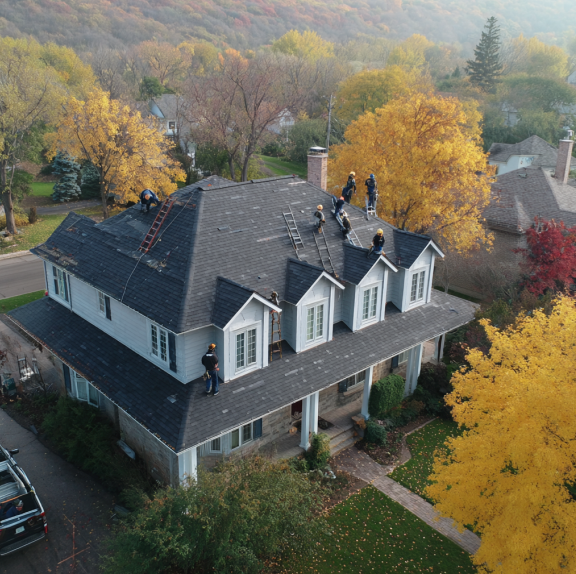When the busy roofing season slows down, many contractors see their phones go quiet. But roofing leads don’t have to dry up once storm season ends. With the right roofing lead generation strategies, your business can stay booked year-round. Roofing lead generation is about consistency, visibility, and knowing where homeowners are searching.
Let’s be honest, the roofing and home exteriors industry typically does not have the cheapest leads. According to CallRail, the average cost per lead for home services search ads is $66.02, but roofing & gutters leads average $186.79 per lead—the highest of any home services vertical. All the more reason to ensure proactive roofing lead generation that works during any season.
Even during the down months, homeowners still require roofing services. From winter leaks and preventative inspections to spring tune-ups and emergency repairs, the demand never fully stops; instead, it shifts. Contractors who understand this shift and position their business with smart roofing marketing strategies stay ahead of competitors who go dormant. This article will show you how to create a steady stream of roofing leads that keeps your crews busy, even when other roofers are waiting for the phone to ring.
Key Takeaways:
- How to maintain a steady flow of roofing leads in slower months
- What to consider before adjusting your roofing lead generation strategy
- The tools roofing pros use to keep their pipeline full
Need expert help right away? JobNimbus Marketing is here to help.
What do most roofing companies miss about digital marketing results?
Most roofing companies miss that lead generation requires consistent systems, not one-time efforts.
Many roofing companies depend too heavily on storm-driven jobs, word-of-mouth referrals, or one-off ad campaigns. That creates major gaps in lead flow. The reality is that roofing lead generation works best when supported by long-term, repeatable systems that homeowners can find year-round.
The most common mistakes roofing contractors make:
- Seasonal dependency: Many roofers rely heavily on storm seasons or insurance-driven work to fill their pipeline. When the weather is calm, calls drop sharply, leaving crews idle and cash flow uncertain.
- Lack of follow-up: Too many roofing companies fail to nurture leads once they come in. If a homeowner isn’t ready to commit immediately, that lead often goes cold. Without follow-up emails, texts, or calls, valuable opportunities are lost.
- Short-term marketing: Some contractors run a burst of ads during peak season but pause everything when it slows down. This start-and-stop approach means they miss out on building long-term visibility, and competitors stay top of mind instead.
- No online footprint: Relying solely on yard signs, truck wraps, or door hangers isn’t enough anymore. Homeowners search online first, and if your business doesn’t appear on Google Maps, review sites, or search results, you’re invisible to a large portion of your market.
Better approach:
- Develop a 12-month marketing calendar that anticipates seasonal slowdowns.
- Build an online presence (website + SEO + reviews) that grows stronger over time.
- Use tools like CRMs to ensure no lead slips through the cracks.
Roofing companies that stop marketing after peak season set themselves up for dry months. Contractors who invest in long-term digital marketing systems—SEO, reviews, PPC, and lead nurturing—see consistent roofing leads all year.
How does Google rank roofing businesses in your city?
Google ranks roofing businesses using proximity, reviews, content relevance, and overall site authority.
When homeowners search for “roof repair near me,” Google decides which companies appear first based on several ranking signals. Understanding these signals helps roofers improve their visibility in local search results.
Key factors that influence local roofing rankings:
- Proximity: How close your business is to the homeowner searching. You can’t control geography, but you can serve multiple service areas with location pages.
- Reviews & Reputation: High-quality reviews with keywords like “roof repair” or “roof replacement” improve trust and ranking. Responding to reviews boosts engagement signals.
- Content Relevance: Roofing websites with specific service pages (“roof inspection,” “storm damage repair”) rank higher than generic sites.
- Website Authority: Fast-loading, mobile-friendly sites with backlinks from local directories and associations (BBB, Chamber of Commerce) rank stronger.
- Engagement Metrics: Low bounce rates, strong click-through rates, and visitors staying on your site signal quality to Google.
Action steps to improve rankings:
- Claim and optimize your Google Business Profile.
- Add location-specific service pages to your website.
- Collect new reviews every month.
- Use schema markup to improve search visibility.
- Track local rankings with tools like BrightLocal or SEMrush.
Roofing contractors who understand and work with Google’s ranking signals gain a real advantage. Instead of competing only when storms hit, they stay visible and top of mind year-round.
What should roofing companies know before choosing a marketing strategy?
Roofing companies should evaluate budget, timeline, support resources, and lead urgency before committing.
Not every roofing company has the same goals or resources. Before diving into SEO, PPC, or social campaigns, contractors should clarify what they want to achieve and what they can realistically sustain.
4 Key Considerations:
- Budget:
Roofing marketing works best with consistency. A $4,500 monthly spend on SEO and PPC is common for competitive markets. Cutting back too soon often stalls results. - Timeline:
- SEO: 3–6 months before strong lead flow.
- PPC: Immediate results, but costs more per lead.
- Social Media & Reviews: Support SEO and credibility long-term.
- Support:
- In-house staff may handle posting and basic updates.
- Agencies provide deeper expertise (SEO audits, paid ad management, and content).
- Lead Urgency:
- Need fast jobs? Prioritize Meta Ads and Google PPC, as well as Google Local Service Ads.
- Want steady growth? Invest in SEO and review-building.
The best results come when roofing companies balance quick wins like PPC with long-term strategies like SEO. That mix ensures steady leads in both busy and slow seasons.
How can roofers keep leads flowing after peak season?
Roofers can maintain steady leads by optimizing profiles, launching seasonal offers, investing in content, running PPC, staying active on social, and nurturing past customers.
Here’s a detailed step-by-step guide roofing companies can follow to avoid slow months:
1. Optimize your Google Business Profile
Your profile is often the first impression homeowners see. Make it a conversion tool:
- Upload fresh photos from recent projects.
- Post weekly updates (offers, tips, seasonal services).
- Use service categories strategically (roof repair, roof inspection).
- Reply to reviews within 24 hours.
2. Launch seasonal service offers
Position your business for off-season needs; homeowners still pay for:
- Winter roof inspections to prevent leaks.
- Pre-spring gutter cleaning.
- Roof tune-ups before storm season.
- Ice dam prevention services in colder climates.
These offers keep crews working and create opportunities to identify future replacement jobs.
3. Build local SEO content
Blog posts and pages that answer seasonal homeowner questions help keep you visible:
- “How to spot roof damage after a winter storm in [City]”
- “Top 5 signs you need a spring roof inspection”
- “Average cost of roof repairs in [City]”
4. Run targeted PPC ads
Ads fill immediate gaps. Focus on urgency-based keywords:
- “Emergency roof repair near me”
- “Same-day roof inspection [City]”
- “Roof leak specialist [City]”
Set daily budgets and track conversion rates so spend translates into booked jobs.
5. Stay active on social media
Social content builds awareness and trust:
- Post “day in the life” videos of your crew.
- Share roof care tips during the off-season.
- Highlight customer testimonials with before/after photos.
- Use Facebook Ads to retarget website visitors.
6. Nurture past customers and referrals
Repeat business and referrals can fill gaps. Build a process:
- Quarterly email newsletters with roof care tips.
- Follow-up calls after 6 months, offering inspections.
- Referral rewards (gift cards, discounts).
Roofing companies that work through this checklist create a reliable system that generates roofing leads no matter the season. Instead of chasing storms, they build predictable demand.
What’s the difference between DIY roofing marketing and working with an agency?
DIY marketing offers flexibility but requires time, while an agency provides expertise, scalability, and proven systems.
Roofers often ask if they should handle marketing themselves or outsource to an agency. Both have pros and cons, but the decision depends on goals and resources.
DIY Roofing Marketing:
- ✅ Control over messaging and spend
- ✅ Low upfront cost
- ❌ Time-intensive for contractors already managing crews
- ❌ Requires learning SEO, PPC, content, and analytics
- ❌ Risk of slow or inconsistent results
Agency Roofing Marketing (e.g., JobNimbus Marketing):
- ✅ SEO and PPC managed by experts with roofing-specific strategies
- ✅ Access to advanced tools (keyword research, call tracking, reporting)
- ✅ Scalable campaigns for busy or slow seasons
✅ Allows contractors to focus on roofing, not ads - ❌ Requires monthly investment
DIY Marketing vs Agency Marketing for Roofers
Factor | DIY Marketing | Agency Marketing |
Cost | Lower Upfront | Higher upfront |
Time Required | High (self-managed) | Low (outsourced) |
Expertise | Limited unless trained | Industry-specific specialists |
Speed to Results | Slower due to trial/error | Faster with proven systems |
Scalability | Limited by the owner’s time | Scales with growth |
For roofing contractors with time and interest, DIY can work. But most find that outsourcing to an experienced agency creates faster results and allows them to stay focused on running jobs.
What should roofing companies do next to grow their business?
Roofing companies should commit to a checklist of marketing priorities and implement them consistently.
The difference between roofing companies that thrive and those that struggle is execution. Successful contractors create systems, track results, and invest consistently.
Next steps roofing contractors should take immediately:
- Update your Google Business Profile with seasonal offers and new photos.
- Collect reviews every week—make it part of your closeout process.
- Launch a small PPC campaign targeting urgent roofing services.
- Plan your blog calendar with seasonal homeowner-focused topics.
- Set up or review your CRM to ensure leads are being tracked properly.
- Build a referral program to encourage happy customers to spread the word.
Roofing companies that work this plan consistently see growth even in slower months. The key is discipline: treat marketing like a core part of your operations, not just something you turn on when leads get low.
Final Thoughts: Year-Round Roofing Lead Generation Success
Roofing leads don’t have to disappear after storm season. With strategies like optimizing your Google profile, running seasonal offers, investing in SEO, and nurturing past customers, your roofing company can keep leads flowing year-round.
Just like storm season brings a surge of calls, a well-planned marketing strategy brings a steady pipeline of roofing leads, no matter the weather. Contractors who treat marketing as a year-round system, not just a seasonal push, build stronger businesses that thrive in both peak and off-peak months.
By now, you’ve seen how to adjust your marketing strategy, create seasonal offers, leverage SEO and PPC, and even decide between DIY marketing and working with an agency. The next step is simple: put these strategies into action. When you build consistency into your roofing lead generation, you’ll find that slow seasons don’t have to be slow at all.
Want results without wasting time or budget? Schedule your free strategy session today.
FAQs About Roofing Lead Generation
How can roofing companies get more roofing leads in the off-season?
Roofing companies can get more roofing leads in the off-season by focusing on SEO, reviews, and seasonal service offers. This ensures steady lead flow when storms aren’t driving demand.
What is the best roofing lead generation strategy for fast results?
The best roofing lead generation strategy for fast results is PPC ads. Paid search puts your roofing business in front of homeowners who need immediate repairs or inspections.
Do roofing SEO strategies work for small towns?
Yes, roofing SEO strategies work for small towns because targeting local keywords helps roofers dominate search results in their service area. Even small markets have consistent homeowner demand.
How much should roofing contractors spend on lead generation?
Roofing contractors should spend about 5–10% of revenue on lead generation. This investment helps maintain visibility and ensures steady roofing leads throughout the year.
Can social media generate roofing leads for contractors?
Yes, social media can generate roofing leads for contractors by showcasing projects, running local ads, and sharing customer testimonials. Active posting keeps your brand top of mind.
Are customer reviews important for roofing lead generation?
Yes, customer reviews are important for roofing lead generation because they influence trust and local rankings. More positive reviews directly increase calls and conversions.
Table of Contents
Keep on learnin'
Related Articles


How to Market a Roofing Company: A Stage by Stage Growth Guide

Winning the Offseason: Fall Roofing Marketing Strategies That Win Customers



